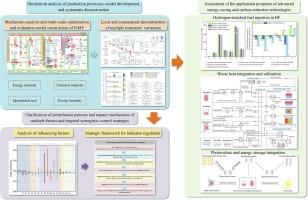Synergistic enhancement for energy-saving, emission reduction and profit improvement in iron and steel manufacturing system: Strategies for parameter regulation and technologies integration
IF 9.9
1区 工程技术
Q1 ENERGY & FUELS
引用次数: 0
Abstract
The steel industry, characterized by high energy consumption and carbon emission, poses a significant threat to global energy and environmental security. In response to the energy conservation and dual-carbon targets, the steel industry must urgently find sustainable pathways for transformation and development. Steel production structure optimization and the application of cutting-edge technologies have been proven to be highly effective. However, the complexity and variability of actual production conditions highlight the absence of a methodology capable of adapting to real production scenarios, elucidating influencing principles across multiple factors, analyzing synergistic mechanisms of multiple indicators, and proposing collaborative control strategies. Furthermore, the potential for technology applications that are closely integrated with the company’s resource endowment remains uncertain, leading to an unclear overall strategy for energy saving and carbon reduction. This study develops a multi-scale optimization and evaluation model for ISMP, incorporating interconnected and matching processes, as well as nested multi-indicators, in response to the context. Subsequently, the disturbance mechanisms of various factors are accurately identified and a multi-indicator synergistic control strategy and framework are proposed. Following optimization, the exergy loss, energy consumption, carbon emission intensity, cost, and pollutant emissions of ISMP per tonne of steel are reduced by 1418.70 MJ, 42.93 kgce, 154.79 kg, 171.21 CNY, and 0.0168 kg, respectively. Additionally, measures such as reducing moisture content in coking coal can effectively regulate multiple indicators. Based on the proposed sensitivity quantification method, the temperature of hot blast is identified as the most effective controllable factor. Technologies like hydrogen-rich fuel injection, integrated waste heat recovery, and solar photovoltaic & energy storage have shown favorable prospects, according to analysis conducted from various angles regarding economic viability and potential for energy-saving and carbon reduction. However, the application of aforementioned technologies may be limited by financial consideration, necessitating cautious and judicious investment choices.

钢铁制造系统节能减排与提高利润的协同增效:参数调节与技术整合策略
钢铁工业以高能耗、高碳排放为特征,对全球能源和环境安全构成重大威胁。为应对节能减排和双碳目标,钢铁行业亟需找到可持续的转型发展之路。实践证明,优化钢铁生产结构、应用前沿技术是非常有效的。然而,实际生产条件的复杂性和多变性凸显出缺乏一种能够适应实际生产场景、阐明多因素影响原理、分析多指标协同机制并提出协同控制策略的方法。此外,与公司资源禀赋紧密结合的技术应用潜力仍不确定,导致节能减碳的总体战略不明确。本研究为 ISMP 建立了一个多尺度优化和评估模型,根据具体情况纳入了相互关联和匹配的流程以及嵌套的多指标。随后,准确识别了各种因素的干扰机制,并提出了多指标协同控制策略和框架。经过优化,每吨钢的 ISMP 放能损失、能耗、碳排放强度、成本和污染物排放量分别减少了 1418.70 兆焦、42.93 千克每升、154.79 千克、171.21 元人民币和 0.0168 千克。此外,降低炼焦煤水分含量等措施可有效调节多个指标。根据提出的敏感性量化方法,热风温度被确定为最有效的可控因素。从经济可行性和节能减碳潜力等多角度分析,富氢燃料喷射、废热综合回收、太阳能光伏& 储能等技术具有良好的发展前景。然而,上述技术的应用可能会受到经济因素的限制,因此需要谨慎和明智地选择投资。
本文章由计算机程序翻译,如有差异,请以英文原文为准。
求助全文
约1分钟内获得全文
求助全文
来源期刊

Energy Conversion and Management
工程技术-力学
CiteScore
19.00
自引率
11.50%
发文量
1304
审稿时长
17 days
期刊介绍:
The journal Energy Conversion and Management provides a forum for publishing original contributions and comprehensive technical review articles of interdisciplinary and original research on all important energy topics.
The topics considered include energy generation, utilization, conversion, storage, transmission, conservation, management and sustainability. These topics typically involve various types of energy such as mechanical, thermal, nuclear, chemical, electromagnetic, magnetic and electric. These energy types cover all known energy resources, including renewable resources (e.g., solar, bio, hydro, wind, geothermal and ocean energy), fossil fuels and nuclear resources.
 求助内容:
求助内容: 应助结果提醒方式:
应助结果提醒方式:


